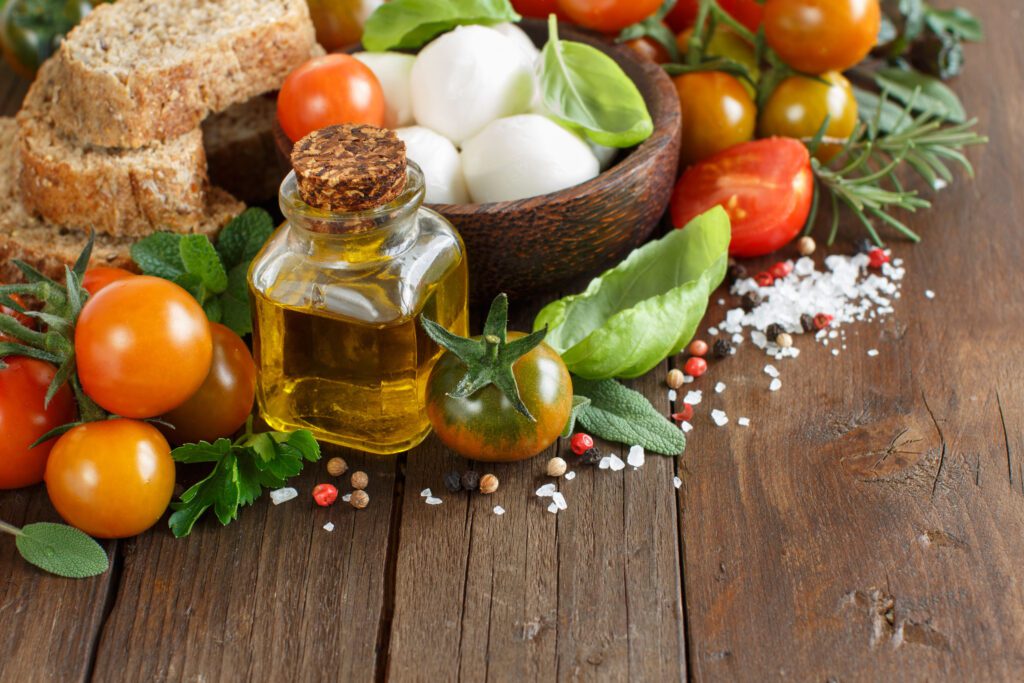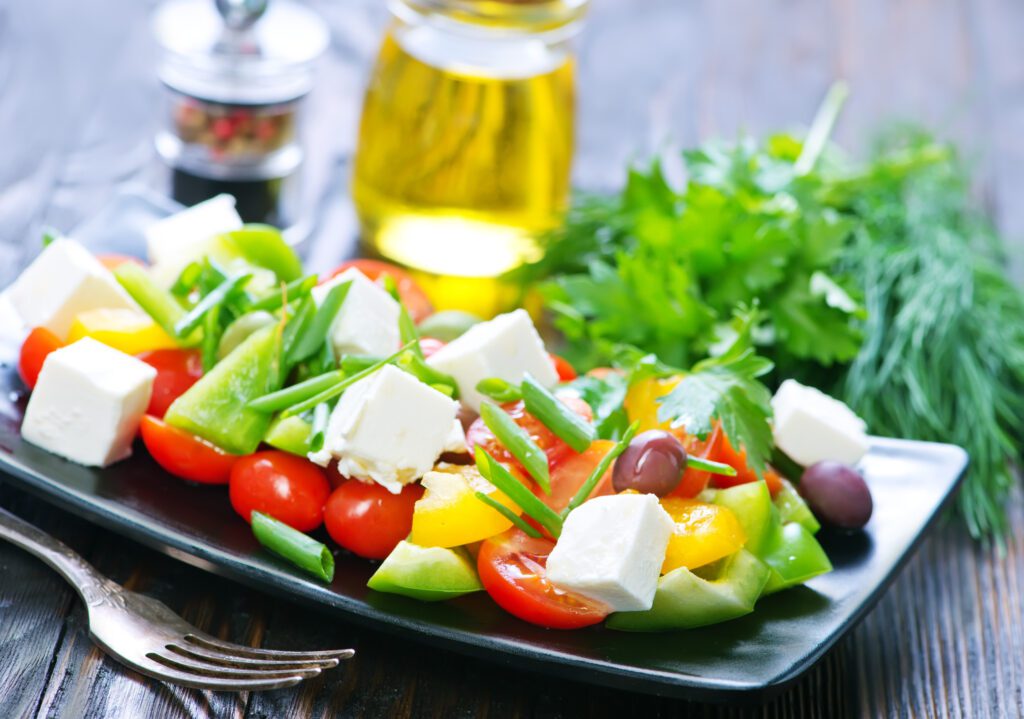The Mediterranean diet includes a variety of whole grains that are integral to its nutritional profile. These grains are valued for their high fiber content, vitamins, minerals, and other beneficial nutrients. Here’s a list of common whole grains that are typically part of the Mediterranean diet:
Guide to the Types of Whole Grains in the Mediterranean Diet
- Whole Wheat: This includes whole wheat bread, pasta, bulgur (cracked wheat), and farro.
- Oats: Whole oats or steel-cut oats are often used in breakfast cereals and baking.
- Barley: Hulled barley or barley groats are commonly used in soups, stews, and salads.
- Brown Rice: A healthier alternative to white rice, retaining more nutrients and fiber.
- Quinoa: Although technically a seed, quinoa is used like a grain and is gluten-free.
- Millet: A versatile, gluten-free grain that can be used in a variety of dishes.
- Buckwheat: Also gluten-free, used in noodles (like soba) and various other dishes.
- Rye: Often found in bread and is known for its distinct flavor.
- Corn: Including whole cornmeal and polenta.
- Freekeh: A type of ancient wheat grain that’s harvested while still green and roasted.
- Spelt: An ancient grain with a nutty flavor, used in bread, pasta, and cereal.
- Amaranth: Another gluten-free option that’s rich in protein and minerals.
- Teff: A tiny grain native to Ethiopia, often used to make injera, a type of flatbread.
- Sorghum: Consumed as a grain or popped like popcorn, sorghum is versatile and gluten-free.
Incorporating Whole Grains into Your Diet
- Substitute Refined Grains: Replace white bread, white rice, and regular pasta with their whole grain counterparts.
- Experiment with New Grains: Try incorporating lesser-known grains like farro, freekeh, or teff into your meals.
- Versatile Use: Whole grains can be used in a variety of dishes, from breakfast cereals to salads, side dishes, and even in baking.
- Portion Control: While whole grains are healthy, it’s still important to be mindful of portion sizes, especially if managing weight or blood sugar levels.
Whole grains are a key component of the Mediterranean diet, contributing to its high nutritional value and benefits for heart health, weight management, and overall well-being.
By including a variety of whole grains in your diet, you can enjoy their health benefits while also experiencing a range of flavors and textures that enhance your meals.
3. Healthy Fats Guide to the Mediterranean Diet
The Mediterranean diet places a strong emphasis on healthy fats, which are integral to its numerous health benefits. These fats are primarily unsaturated, including both monounsaturated and polyunsaturated fats, which are known for their positive effects on heart health and overall well-being. Here’s a list of common sources of healthy fats in the Mediterranean diet:
→ Olive Oil
- Primary Source: Extra virgin olive oil is the main source of added fat, used for cooking, dressings, and dips.
- Benefits: Rich in monounsaturated fats, particularly oleic acid, and contains beneficial antioxidants.
→ Nuts and Seeds
- Varieties: Almonds, walnuts, pistachios, hazelnuts, pine nuts, sunflower seeds, sesame seeds, and flaxseeds.
- Usage: Eaten as snacks, sprinkled on salads, or used in baking and cooking.
- Benefits: Provide a mix of monounsaturated and polyunsaturated fats, fiber, protein, and various vitamins and minerals.
→ Fatty Fish
- Types: Salmon, mackerel, sardines, trout, and herring.
- Benefits: Rich in omega-3 fatty acids, which are crucial for brain health and reducing inflammation.
→ Avocados
- Usage: Consumed as a fruit or used in salads, sandwiches, and as a spread.
- Benefits: High in monounsaturated fats and loaded with fiber and potassium.
→ Olives
- Varieties: Green, black, Kalamata, and others, eaten whole or used in cooking and salads.
- Benefits: Good source of monounsaturated fats and antioxidants.
→ Some Dairy Products
- Types: Cheese and yogurt, particularly those from grass-fed animals.
- Note: While not as high in monounsaturated fats, they provide a mix of fats and are often included in moderation.
→ Eggs
- Usage: Used in various dishes, though not primarily for their fat content.
- Benefits: Eggs contain healthy fats and are a good source of high-quality protein.
In the Mediterranean diet, the focus is on replacing saturated fats and trans fats with these healthier fats. The inclusion of these fats in the diet contributes to its heart-protective and anti-inflammatory properties.
4. Fish
In the Mediterranean diet, both fresh and canned fish are considered beneficial and can be included in your dietary choices. Here’s a breakdown of each type:
→ Fresh Fish
- Nutrient Profile: Fresh fish is known for its high quality of protein, omega-3 fatty acids, vitamins, and minerals.
- Variety: A wide range of fresh fish options allows for diverse culinary experiences.
- Flavor: Fresh fish often offers superior taste and texture compared to canned versions.
→ Canned Fish
- Convenience: Canned fish is a convenient and often more affordable option. It has a long shelf life and can be a practical choice for quick meals.
- Nutrition: Many canned fish options, like sardines, tuna, and salmon, still provide a good source of omega-3 fatty acids and protein. However, it’s important to check for added ingredients like salt.
- Sustainability: Some canned fish options can be more sustainable, as they often use smaller fish that are more abundant and have a lower environmental impact.
Considerations
- Mercury Content: Be mindful of the mercury content in certain types of fish. Larger fish like tuna can have higher mercury levels, which can be a concern, especially for pregnant women and young children.
- Sustainability: Consider the environmental impact and sustainability practices of the fish you consume. Over fishing and harmful fishing practices are significant environmental concerns.
- Preparation Method: How you prepare the fish is also important. Grilling, baking, or broiling are healthier options compared to frying.
Both fresh and canned fish can be part of a healthy Mediterranean diet.
The choice often depends on availability, convenience, and personal preferences. Including a variety of fish in your diet, prepared in a healthy way, can contribute to the overall nutritional quality of your meals.
Remember to be conscious of the source and the way the fish is processed or prepared to make the healthiest choices.
5. Poultry, Eggs, and Dairy
In the Mediterranean diet, poultry, eggs, and dairy products are consumed in moderation, providing essential nutrients like protein, calcium, and vitamins. Here’s a list of these types of foods commonly included in the diet:
→ Poultry
- Chicken: Especially lean cuts like breast meat, either grilled, roasted, or baked.
- Turkey: Similar to chicken, lean turkey breast is preferred.
- Duck: Less common but can be included occasionally.
- Other Poultry: Depending on regional availability, this could include items like quail or guinea fowl.
→ Eggs
- Chicken Eggs: The most commonly consumed type, versatile in cooking.
- Duck Eggs: Richer and larger than chicken eggs, used in similar ways.
- Quail Eggs: Smaller and often used as a delicacy in various dishes.
→ Dairy
- Cheese: Preferably traditional and locally produced cheeses. Feta (Greece), Parmigiano-Reggiano, and Pecorino (Italy) are common examples.
- Yogurt: Especially plain, natural, or Greek yogurt, which is higher in protein and lower in sugar.
- Milk: Often consumed in moderation, with a preference for goat’s or sheep’s milk in certain regions.
- Other Fermented Dairy Products: Such as kefir, which is rich in probiotics.
Guidelines for Consumption
- Moderation: Poultry, eggs, and dairy are not the central focus of the Mediterranean diet but are consumed in moderation.
- Quality Over Quantity: Preference is given to high-quality, locally sourced, and organic products where possible.
- Varied Use in Dishes: These foods are often used to complement plant-based ingredients, rather than as the main focus of the dish.
Poultry, eggs, and dairy play a supportive role in the Mediterranean diet, contributing valuable nutrients while maintaining the emphasis on plant-based foods.
These items are used in a way that enhances the flavor and nutritional value of meals, aligning with the overall principles of moderation and balance characteristic of the Mediterranean lifestyle.
6. Red Meats and Sweets
Red meats and sweets are consumed less frequently compared to other food groups like fruits, vegetables, whole grains, and healthy fats. This moderation is a key aspect of the diet’s health benefits.
Here’s a breakdown of how red meats and sweets are typically approached in the Mediterranean diet:
→ Red Meats
- Beef: Lean cuts are preferred, and consumption is limited to a few times a month.
- Lamb: Commonly used in Mediterranean cuisine, but again, lean cuts are chosen, and portions are kept moderate.
- Pork: Although less common, when consumed, lean cuts are preferred.
- Game Meats: Such as venison, occasionally included in some regional variations of the diet.
- Preparation: Red meats are often grilled, roasted, or used in stews in small amounts, emphasizing the use of herbs and spices for flavoring rather than heavy sauces.
→ Sweets
- Fruit-Based Desserts: Fresh fruits often serve as a dessert in the Mediterranean diet. Dried fruits and nuts are also common.
- Honey: Used as a natural sweetener in place of refined sugars.
- Pastries and Cakes: Consumed occasionally, these are typically less sweet and smaller in portion size compared to typical Western desserts. Olive oil is often used in baking instead of butter.
- Dark Chocolate: Enjoyed in moderation, dark chocolate (preferably with a high cocoa content) is a common treat, providing antioxidants.
- Special Occasions: Sweets are more common during celebrations and special occasions, reflecting the diet’s emphasis on balance and moderation.
Moderation and Balance
- Infrequent Consumption: Both red meats and sweets are not daily staples but are consumed in moderation.
- Portion Control: When these foods are included in the diet, portions are smaller, focusing on the quality of the ingredients and the enjoyment of the food.
- Healthy Preparation: Cooking methods and ingredients for both red meats and sweets in the Mediterranean diet lean towards healthier options.
The approach to red meats and sweets highlights its principle of balance. It doesn’t completely eliminate these foods but encourages moderate consumption, focusing on the overall dietary pattern that is rich in plant-based foods, whole grains, healthy fats, and lean proteins.
Guide to the Mediterranean Diet – Sample Meal Plans
Day 1:
- Breakfast: Greek yogurt with honey, nuts, and fresh berries.
- Lunch: Grilled vegetable and quinoa salad with olive oil and lemon dressing.
- Dinner: Baked salmon with a side of roasted Mediterranean vegetables.
Day 2:
- Breakfast: Whole grain toast with avocado and poached egg.
- Lunch: Lentil soup with a side of whole wheat pita bread.
- Dinner: Grilled chicken with a mixed greens salad.
Health Benefits Beyond Nutrition
Physical Health
Adopting the Mediterranean diet can lead to better heart health, weight management, and reduced risk of chronic diseases.
Mental and Emotional Well-being
The diet’s emphasis on whole foods and omega-3 fatty acids has been linked to improved mood and reduced risk of depression.
Social and Cultural Aspects
This diet encourages communal meals and taking pleasure in eating, fostering social connections and a deeper appreciation of food.
Guide to the Mediterranean Diet – A Call to Action
The Mediterranean diet isn’t just about food; it’s a lifestyle that encourages a balanced approach to eating, physical activity, and enjoying meals in good company. It’s a sustainable and enjoyable way to improve health and well-being.
Starting today, even small changes like adding more vegetables to your plate or switching to olive oil can set you on the path to a healthier life.
The Mediterranean diet is more than a diet; it’s a journey towards a healthier, happier you.


